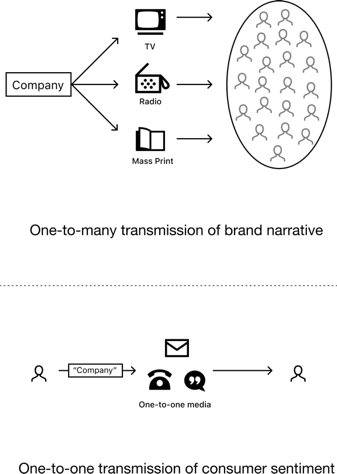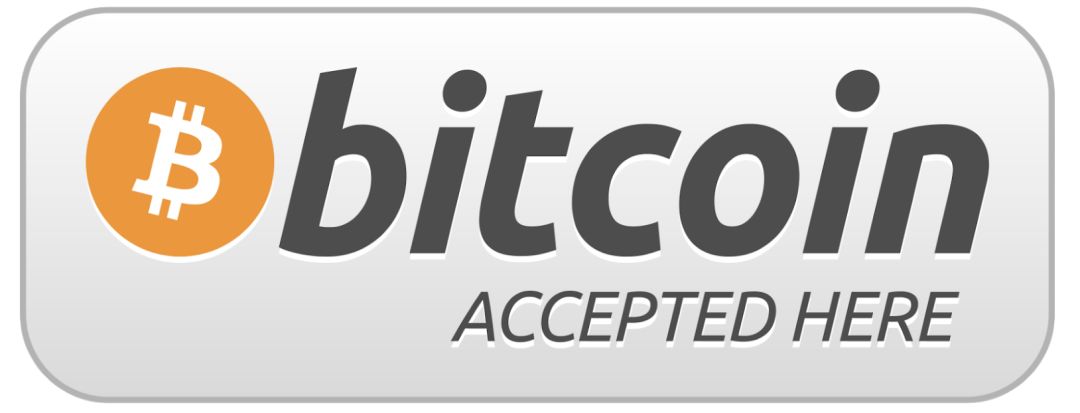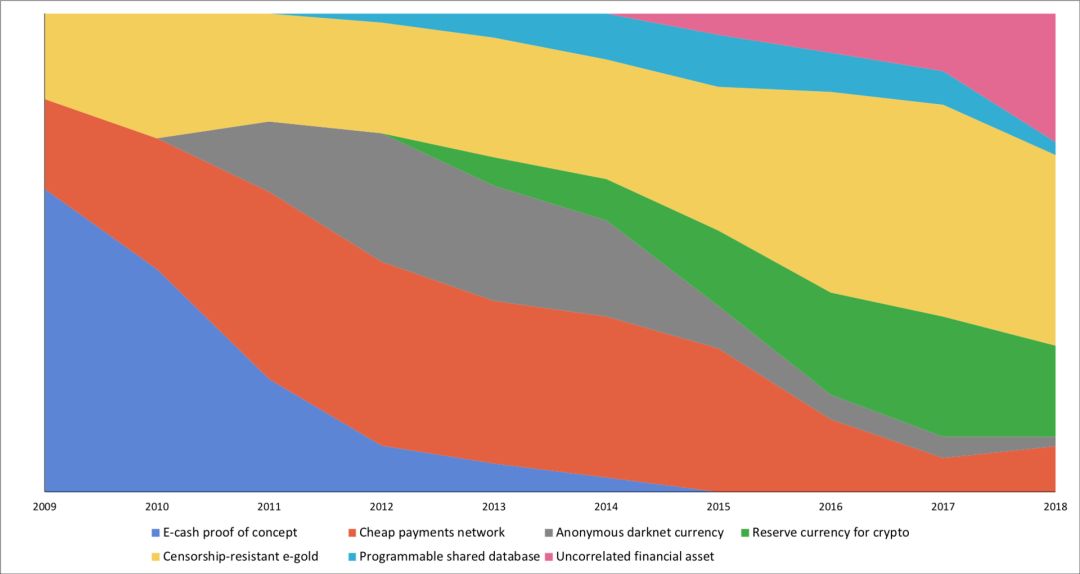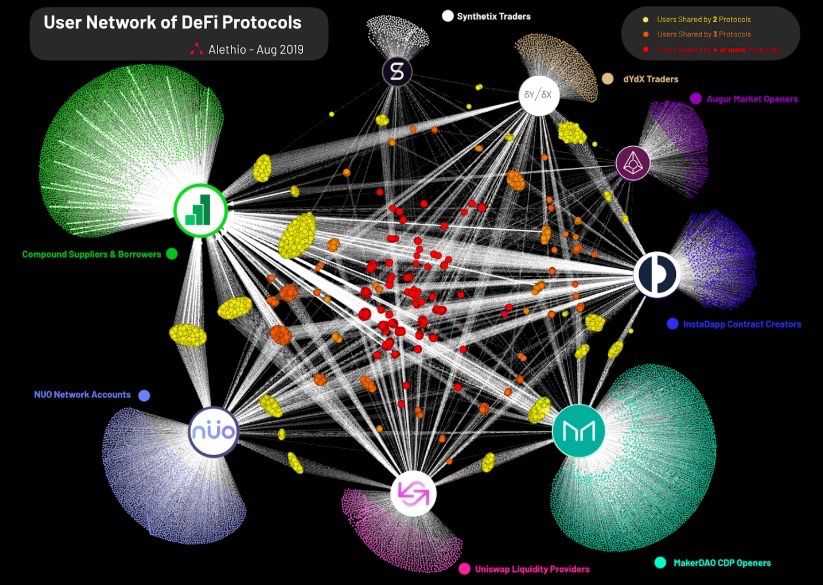Headless Brands: From Corporate Management to the Community-Driven Brand Era, Taking Bitcoin as an Example
Author: DAO translators to develop group
Source: Fat Garage
Editor's Note: The original title was "Headless Brands"
Summary
Traditional brands are generally planned and designed directly by enterprises. In the centralized model of enterprises' direct management of brands, the identity characteristics of brands are synchronized with corporate planning, but the rise of Internet media poses a challenge to this model. The new blockchain-based decentralized organization goes one step further and provides users with financial incentives to encourage them to spread the brand's story.
- BOSCore co-founder Winlin: Blockchain technology should serve the principle of application landing and detailed explanation of airdrop coin burning proposal | Chain Node AMA
- French central bank deputy governor calls for the establishment of a settlement and payment system based on DLT technology, and open trial of blockchain technology
- Public chain survival note: I want to do outsourcing
We introduce the concept of Headless Brands in this article to explain the source of power for community-driven brand projects. They do not have a centralized management agency. We will discuss some elements in the life cycle of a headless brand represented by Bitcoin, and the process from brand formation to acceptance, and try to propose strategies to maintain brand coherence.
Author: Toby Shorin, Laura Lotti, Sam Hart Bryan Lehrer
Other Internet is a planning and research company.
About the brand
1.1 What is a brand?
A brand is a collection of concepts, expectations, impressions, and reputations related to a particular entity. Generally speaking, the carrier of a brand is a company or product. A brand means different things to different people. For example, from the perspective of brand operators and consumers, a brand may have N interpretations. For example, WeWork is a "not bad" brand in the eyes of some people.
But the brand is not the product itself, the brand is more a reflection of the product's characteristics and delivery methods. When people come into contact with a product, they make a first impression of the brand. Products will have some features that impress users, and these features also help marketers position their products.
Brands are not just the so-called "visual identity tags", but they are generally remembered by graphic representations such as excellent trademarks, product designs, and advertisements.
So, if the brand is not a product, copywriting, mission statement, founder's vision, designer's aesthetic, or employee behavior, what is it?
Brand is a cultural phenomenon that only appears when people are exposed to these specific things, and brands live in the minds of those who realize it.
People have a first impression of a particular brand, and they also associate something with it. But as the brand grows, its reputation will gradually become more and more important. Users share their evaluations (that is, word of mouth) with each other, and people will fuel a brand in this contagious mood.
1.2
What is a centralized brand and a centralized narrative?
Traditional advertising media provides convenience for companies to promote their brands. What users can hear often depends on what the company wants to produce, and to a certain extent they determine what kind of users can get what kind of information. Viewers continue to receive information about the brand through advertisements in print publications, radio and television media. These ads are delivered in batches, and the audience forcibly remembers a brand under the brainwashing of repeated content.

Of course, personalized information transfer between people is actually going on, but it will be limited by the existing communication infrastructure. Brand promoters mainly transmit information by sending messages, emails or telephones.
As a result, some information aggregation service providers, such as Zagat, Consumer Reports and Kelly Blue Book, have found opportunities to become credible pre-Internet age information aggregation intermediaries.

Icon by Thomas Heibig, Portfolio Noun Project
Above: One-to-many communication of brand narrative, using traditional media such as TV, radio and print publications
Below: One-to-one communication based on user experience, word of mouth, telephone, email to refer
During the transition of brand image from traditional media to online media, uncertainty has increased greatly. The Internet has greatly reduced the threshold for publishing information. Anyone can access the published materials, and any user can share their views publicly. User rating websites like Yelp reduce the reliability of information provided by traditional information aggregators, introduce new channels for users to obtain brand information, and reach consensus on a company's brand. Today, public opinion, including user review sites, personal blogs, and social media timelines, forms a new part of brand narrative. They are more accessible and are the “look” of the brand, which can be compared and verified with official brand information.

Above: Many-to-many communication of brand narrative and user experience
Because brand communications are limited by the number of people who connect with them, the accessibility of information and the speed with which it is spreading greatly affect them. Nowadays, the mainstream sentiment of consumers is becoming more and more obvious. Both positive and negative sentiments about brands can be quickly escalated and spread throughout the network.
Most small companies have nominally positions for managing brands (usually CEO, CMO, or vice president of marketing) to manage people's impressions and expectations of the product. However, with the emergence of social networking sites, a large number of real-time social streaming media have more important signals than a small number of review sites, and the marketing team is required to meet the continuous demands of consumers. Sisyphus in rolling stones.
Many companies employ social media managers to use passive or active brand management strategies to maintain brand image as a response.
The passive strategy aims to synchronize the brand image management behavior with relevant news on the media in time and dynamically manage user feedback in real time. Proactive strategies are designed to produce content that can be widely disseminated online, or to induce customers who have a strong sense of brand identity to act in favor of the brand, and then make a case. The latter strategy is often referred to as "value-based brand communication" or "net influencer marketing", which relies on user activities to organically increase brand awareness and even defend the brand from negative feedback. This brand management attempts to use the strategies inherent in the current online paradigm to guide the overall story tone.
Although these methods are widely used, in the process of managing reputation and controlling brand narrative, the company consumes a lot of resources and the market risk is very high. The fundamental tension in the control of brand narratives in the online age is that most companies impose hierarchical brand management models on communication processes that have practically become distributed, license-free. When the emerging online meme culture meets censorship-resistant infrastructure, brands will have their own lives.
Headless Brands
So far when discussing the topic of brand, we have been talking about centralized companies, and they are trying to "manage" their brand. Most joint-stock companies bring together workers (production) and governance (strategic direction) to centrally manage their trademarks, information, and other "brand assets." For such companies, influencer marketing (impact marketing) is a common method they use to tell stories to the market.
* Influence marketing is a marketing method that works with opinion leaders (broadly speaking, experts in a certain field, celebrities, bloggers, Youtuber, influencers, etc.).
But here we find an interesting phenomenon. Internet celebrity marketing is an example of an early transition from centralized brand management to decentralization.
When the ownership of the agreement belongs to every user in the network, who can get the power to manage the brand? Especially when these users also work for the network. That is, once they can benefit from continuous contributions (in helping the network grow), these users will automatically spread and publicize the project. However, because there is no central agency to hire these "brand advocates", the descriptions around the product or service are mixed and easy to tear down.
Web 1.0 and 2.0 network technologies eliminate the marginal cost of brand communication, push the power of narrative beyond the network, and weaken the cohesion of real-time social media brand vitality and influencer marketing. Similarly, the ownership and contribution models that emerged in Web 3 pose a threat to brand cohesion, while also providing opportunities for community-driven models.
Let's take Bitcoin as an example.
2.1
Bitcoin
Bitcoin is well deserved to be the first Headless Brands.
Bitcoin is the pioneer of all modern cryptocurrency projects and is by far the most well-known brand in the field. Many people who have never had contact with Ethereum, P2P networks, or blockchain know Bitcoin.

Bitcoin has many powerful brand features, including an extraordinary origin story. But in fact, no one or entity is responsible for maintaining this story. Bitcoin is what we call a headless brand. Although Bitcoin was named and given a visual ID by a visionary founder, Satoshi Nakamoto chose a pseudonym and has now completely disappeared from the public eye. All subsequent brand-guaranteed assets, information, and positioning are created by community stakeholder groups. This has become the driving force behind the evolution of Bitcoin as a brand.
Although Bitcoin's core contributors have influenced Bitcoin's narrative, there are millions of other stakeholders, many of whom have made meaningful contributions to the Bitcoin brand. Nic Carter's vision for Bitcoin captures the core of the evolution of Bitcoin's emerging brand proposition: from electronic cash to censorship-resistant value storage to unrelated financial assets. These claims often conflict with each other, but they all contribute to the overall brand image of Bitcoin. Or we can say that there are many different bitcoin brands that collectively promote bitcoin's broader brand awareness. The point is, each argument has driven new market dynamics and a new buyer base.

visions-of-bitcoin
Related to this, the Bitcoin ecosystem can be divided into several ideological camps. Bitcoin software was originally distributed through the cypherpunk mailing list, and this initial group of crypto anarchists formed such a fragment. When technological enthusiasm spread to the CPU overclocking community, Bitcoin also broadly resonated with dissatisfied political factions formed after the financial crisis, from the Tea Party to the Occupy.
Since then, many libertarians have renewed their interest in Austrian economics and joined the ranks of "Bitcoin Maximizers." This group is characterized by their unwavering commitment to Bitcoin's currency hegemony Shifting faith. The extremists constitute the so-called "last lenders" precisely because of their insistence on refusing to sell bitcoin, which supports the lowest price of bitcoin. Maximalism itself is a weird form of ideological extremism. The "Bitcoin Carnival" is an example. They extended the ideal of libertarianism to dietary habits and declared that they opposed both fiat money and "legal food ".
Despite political differences in many ways, it is a common goal to unite these extremist organizations, that is, to bring about a super bitcoinization event, which is to replace the single non-state alternative, Bitcoin. The possibility of fiat money.

Above: hyperbitcoinization (Bitcoin extremists)
The last but crucial pillar of the Bitcoin brand is its protocol features. Many of Satoshi's early design decisions have become identifiable elements of the Bitcoin brand's existence.
"Hard currency"-a fixed supply of 21 million and the resulting deflationary economy has been the main driving force behind the adoption of this policy.
"Illegal currency"-As a non-state currency, Bitcoin is often embroiled in anti-dictatorship, economic crisis, and collapse narratives.
"Proof of Work"-A new consensus mechanism introduced by Satoshi Nakamoto solved a difficult problem in cryptography; recently, the term has also begun to be used as a metaphor for any proof of energy and resource expenditure.
"White Paper"-Bitcoin's publishing format is one of its most iconic elements, spawning thousands of imitators.
"Blockchain"-an abandoned phrase "blockchain" that was mentioned in the white paper has its own life.
In the absence of structured brand management, these design decisions became a well-known principle of the Bitcoin brand. The immutability of these core protocol mechanisms is more convenient for everyone to tell stories. But the fork of Bitcoin Cash is an exception to this rule.
When Bitcoin Cash forks, OG Bitcoiners can express their trust in the new brand by adopting an amount equal to their balance in the fork chain. The fact that many people did not choose to take over BCH, or simply abandoned BCH on the exchange, shows that there is a profound brand difference between these two visions. Although BTC has strengthened since the "fork", BCH has experienced more "forks" and also illustrates the fact that the bitcoin cash brand continues to develop, albeit in a more painful way.
To sum up, the transformation of the Bitcoin brand has three characteristics:
1) Bitcoin is headless and completely lacks a centralized entity that tries to control the existence of its brand; 2) its defined protocol design decisions are immutable; 3) users are money stakeholders and workers in the network, they Both will benefit from the increasing popularity of the Bitcoin protocol. The financial interests of users in the agreement prompted them to spread their bitcoin stories. If the brand is a consensus system, then Bitcoin constitutes multiple stories that converge on a single Schelling Point *: the dominant BTC main chain.
* Xie Lin point: Refers to a manufacturer's intention to influence competitors' expectations of the manufacturer's actions, so that competitors can make decisions based on the expectations of the manufacturer.
2.2
Exit vs. fork and headless governance
The Bitcoin hard fork was first a narrative divergence, starting with two different visions of the blockchain, and ultimately leading to two different Bitcoin brands-BTC and BCH.
Headless brands, especially those without formal governance structures, face the risk of such a narrative fork. This raises another set of questions: To what extent do we want to reduce disagreement instead of letting vision, narrative, and aesthetic diverge and develop in our own way?
The controversial hard fork stems from divergent narratives among existing stakeholders. However, although these differences may jeopardize the consistency of the original brand, allowing dissidents to withdraw may help consolidate the narrative, thereby attracting new experts and avoiding the danger of internal slaughter. For example, Bitcoin's main community has benefited from a clear decision on the size of the Bitcoin block, and dissidents have moved cleanly to the BCH fork chain.
The first-tier projects with on-chain governance, such as Decred, Tezos, and Amoveo (and upcoming projects such as Polkadot and Dfinity), provide a different set of strategies for handling narrative branches. They internalize the choice of withdrawal and re-state it as a more powerful voice, which is no different from the unified effect of universal suffrage in modern constitutional democracy.
For example, Decred and Tezos approved support for backwards incompatible changes by token holders' on-chain voting. Amoveo has created a road to legitimacy by adopting a "fork-futures" model, originally proposed by Paul Sztorc before the BCH fork, in which models are used to resolve different protocol rule sets using predicted market outcomes. These strategies provide new ways for their communities to form metaconsensus, whether good or bad.
Although these designs cannot prevent users who do not recognize themselves in the main narrative from logging out of the system completely, these projects can solve the problem by providing an additional in-protocol path to change the dynamics of community cohesion and coordination around the brand narrative. Protocol design choices, especially governance models, directly affect the consistency of headless brands.
Headless brand development
"Headless" is a brand new product and service model, and its success is entirely due to the distributed encrypted network. Decentralized brands are driven and communicated by users who are truly empowered and motivated to create their own stories.
However, just using a blockchain network does not guarantee the success of a headless brand strategy. One of the questions is, how does this license-free decentralized system maintain brand coherence and consistency? Is there a good time for "decentralization" for web 3.0 organizations? How are the system's protocols and products designed to find and adopt the right audience? In this section, we will discuss the elements of a successful "headless" brand at all stages of its continuous development.
3.1 Anonymous Founder
Take Bitcoin as an example. As the ancestor of decentralized cryptocurrency, Bitcoin has a unique brand reputation. Inspired by this, other organizations also recognize the value of hidden project sponsors. For example, Monero's white paper was also published under the pseudonym "Nicolas Van Saberhagen", and the code base was initiated by a group of anonymous developers.
New projects such as Grin and Fomo3D also use pseudonyms for distributed development, which in turn avoids regulatory issues while injecting a mystery of punk passwords into their origin stories. One of them, Grin, named the white paper Mimblewimble (the tongue-binding spell used in the Harry Potter series "Holy Death") and posted it on the # bitcoin-wizard IRC channel. Several members of its core development team used aliases, such as the project The founder signed the name "Ignotus Peverell" (owner of the invisible cloak in Harry Potter). Grin's headless is supported by other powerful brands. Its rebellious, playful face sign-allowing people to stick it on the face of the photo, which makes it ideal for the spread and memorial of altcoin.


3.2 Whether the individual is the key to success
"Bus factor" is a typical metric to evaluate the degree of decentralization of a system organization. We can measure the value of a brand through such questions: If a core team member or founder leaves due to various factors, the brand will be affected by this. How much damage?
Ethereum is an inspiring example. The brand of this project is largely related to its founder Vitalik. Vitalik may be the only person in the Ethereum ecosystem with the ability to change the characteristics of the brand, so he may become this "bus factor Key figures. However, the Ethereum team has made some headless designs, indicating that they are trying to minimize the "personal influence", such as the endorsement of related projects using the revised Ethereum logo. In addition, the question about what ETH is (is it a world computer? Or money? Or is it a "Lego building block" for making money?) It proves that the Ethereum brand is undergoing headless evolution. Vitalik has not stated on the issue of "ETH is money", but the vitality of the community and the power of the #DeFi brand have proved that Ethereum's dependence on its founder is decreasing.
In contrast, TRON, as a copy of Ethereum (from the plagiarized white paper to the standard for the "TRC-20" smart contract), revolves around a personal worship of its CEO Justin Sun. So when Sun announced that the much-anticipated dinner with Warren Buffett was postponed for health reasons, TRON's tokens fell by 13.5% in 12 hours. This shows that building brand around the role of founder is potentially risky: in any Web 3.0 brand strategy, identifiable founders can be the key point of failure and affect market dynamics in a sudden and unpredictable way.
3.3 White paper
The white paper began with the reproduction of the way Bitcoin was issued, and has since become a trend and a tradition in the blockchain industry. Especially for headless entities, the white paper plays a key role in setting the tone and direction for the sustainable development of the project.
As in the Constitution, we see that we can see the contrast between the textualist and the intentionalist describing the initial construction. This also applies to white papers and pioneering technical drafts and information exchanges. What does Satoshi Nakamoto mean by "peer-to-peer cash"? How does Vitalik use the term "smart contract"? Obtaining meaning from text alone, or observing these artificial creations through an intentional eye, can lead to very different results.
Just as there are 1,000 Hamlets in the hearts of 1,000 readers, in the case of incomplete information provided, or to fill the corresponding gaps, or to pursue deeper meaning or the true intentions of the founder, the white paper is constantly being re-interpreted . Since the design of cryptocurrencies directly affects issuance and distribution, selective interpretation of a passage (for example, accepting or rejecting ASICs) can lead to huge wealth distribution differences.
Therefore, even in projects where the founders are anonymous or completely disconnected, this headless dynamic interpretation and reconstruction that fills the gap is by no means completely disordered, and active followers will find a way to promote this (unknown project initiated Human) headless projects are moving forward.
3.4 Product brand differentiation vs agreement
Although product brands usually have a clear focus, should the agreement follow the same strategy? Generally speaking, the first layer protocol is usually used to define universal and universal protocols, and various applications are used to meet various highly differentiated specific needs. Projects such as IPFS, Bitcoin, and W3C standards are all designed to achieve and deliver universal standards, functions, or platforms designed according to their ideas. This tendency towards minimalism and universality is no different from the universal design language adopted by global infrastructure companies such as IBM, Oracle and AWS.

However, a generic brand strategy seems to conflict with the efforts needed to expand its decentralized network. For example, to expand a decentralized network requires building a product or solution that spans multiple layers and integrates vertically. If the product or solution shares the brand element with the underlying protocol, it will be confusing, because the diversity and complexity of the upper product / solution from the brand concept will contaminate the minimalism and generality of the underlying protocol.
However, some projects successfully avoided this challenge while pursuing the construction of the ecosystem. The method used was to let team members participate in the construction of the second and third layers of the project with the new brand. For example, in 2018, Blockstack co-founder Ryan Shea and another founding engineer joined an independent organization based on the Blockstack network, which is a high-profile attempt at this strategy.
3.5 Discover Product-Market Fit (PMF)
To quote a famous quote from Clayton Christensen, traditional startup brands are designed to solve a job that is still to be done. Especially in the B2B market, a startup brand often communicates with target customers, asks them specific questions, and makes a commitment to solve these problems. For early-stage venture capital Web 2.0 companies, brands represented the following:
1. A description of "the problem that can be solved, the work to be done", and a commitment to find a product / market fit;
2. Target customers and expected market size.
In this scenario, the role of the brand manager is to establish an interface between the product and the potential customer base. When products are finally connected to the right customers, brands often also restructure adaptively, consolidating their "brand market fit".
Regardless of whether it is a headless project, how to find a suitable product market fit in the Web 3.0 era? In a sense, they don't need it. Because in a highly decentralized decentralized system, the products and solutions that community members find for themselves have in turn become "market product fits." Cryptoeconomic protocols themselves have become a market framework (for participants) looking for potential products and applications. The work of exploring the possibilities, discovering or testing different application cases and solutions is assigned to each member of the broad ecosystem, so that dripping water can hold all ships.
Decentralized finance (DeFi) is a type of example that appears in the Ethereum ecosystem. However, DeFi is not a single coordinated entity, but a series of new financial products based on the Ethereum protocol and non-permissible composability. The most famous of these are MakerDAO and Compound Finance, and the field is growing rapidly. Similarly, DeFi is not a single narrative or aesthetic. Each project can freely tell its own story and define its own use cases, but they also gather together under the #DeFi banner, which strengthens the cultural gene of Ethereum's “programmable currency”. . Maker's recent failure to apply for a DEFI trademark seems to further support this argument.
The discovery of DeFi as a core instance can be attributed to: A) the development of the token standard, B) the Ethereum holders and traders community looking for new instances, hoping to increase their wealth, but also cannot arbitrarily infer the new currency or smart Deploying the contract to the ecosystem can ensure that the community can find success stories or use cases.

Above: Alethio DeFi series
Advanced Strategies for Headless Brands
Web 3 projects are all open source in nature, which means that technology can not only transfer from one protocol level to another, but also the entire state history can be forked. This raises the question: How can the project maintain a competitive advantage if the project no longer has exclusive rights to the technology or underlying data?
Brands are one of the most valuable assets of a decentralized agreement. A headless brand strategy is an ecological issue that requires mobilizing decentralized participants. In essence, it provides agents to different stakeholders so that they can coordinate more effectively and feel connected with the brand. In this case, what the project can do is provide resources, tools and method equipment for various stakeholders so that they can converge around the same story.
Here are some suggestions for various participants in the headless brand ecosystem, hoping to promote and strengthen the social consensus of emerging stories.
4.1 Protocol Developer
4.1.1 Security
Protocol developers can make design choices in programming languages that play a key role in providing initial conditions for the emergence and development of headless brands.
For point-to-point protocols and encrypted network security, the choice of passwords and security models remains key to brand trust. Whether or not any security breach is exploited, it can directly damage the brand built around it, and Ethereum Classic and Horizen are still rebuilding their brands with 51% attacks.
4.1.2 Node operator experience
Although node operation specialization is already a common trend, promoting consumer node operations may be beneficial for headless brands, which may also help network availability and decentralization. How can running nodes bring more compelling experiences? How do I signal my friends that I am running a node? Can the experience of running nodes be comparable to games? Blockchain projects may learn from older distributed computing projects such as SETI @ home, Genome @ home, and Folding @ home to transform public-use distributed computing into user-oriented applications. *
* For details see: https://en.wikipedia.org/wiki/List_of_distributed_computing_projects
In the Clovers Network (meaning Clover) game, players "dig out" a new arrangement of visual patterns as a "proof of work", which shows that the game-like social layer can both enhance and encrypt Legalization of coins. Although many people believe that users of blockchain applications "do not even know that the applications they are using are based on blockchains", improving the mining, mortgage and node operation experience may still be a fruitful innovation route.
4.1.3 Token Ownership Experience
If each token and protocol has its own brand, why can token ownership only use the mediocre metaphor of a "wallet" that displays numbers? Can tokens and crypto assets be presented directly in front of the user's mobile phone? Or transform token ownership into an aesthetic or collective experience in which a crypto asset portfolio can be presented to token holders and projects like Pinterest's interface or Instagram's picture stream. What determines the design and implementation of these experiences is the development of infrastructure components, which usually do not belong to a single protocol, such as the wallet and content production markets. Projects that value their own brand and want to build network effects around user social sharing value may want to consider adopting this strategy.
4.1.3 Governance
As shown in the previous examples of Bitcoin, Tezos, and Amoveo, the governance model of the protocol directly affects the strategy of headless brands. Projects should ensure that their brand strategy reflects and follows protocol design choices. In traditional media, brand strategy is bound to be limited by product characteristics, and the headless features of the Web 3 brand directly have the functions claimed or withdrawn in the agreement.
4.2 Open source community
Under the ideas of opinion leader marketing and "decentralized brand management", developers, contributors, and celebrities in the community are also a kind of publicity and network effect resources. The following are some of the rich social layers of the project to show the technology and related brand appeal. method.
4.2.1 Brand composability
The project can gain social recognition from the companies that choose to build it. Combinability has already appeared in the Ethereum ecosystem, such as folk stories such as #DeFi. In the same way, the emergence of new projects on the agreement can enhance the credibility of related brands! cDAI is a living example. It benefits both the Compound and DAI brands. Developers in the project ecosystem need more opportunities for such "combined brands."
4.2.2 Developer Experience
Learning a new development stack is a significant investment for individuals, and many developers have strong personal insights and aesthetic preferences for the tools they use. Function programming design, which contributes to the language ecology such as JS, Rust, and WASM, is the embodiment of the powerful subdivision of interest knowledge base in the Web 2.0 era, and its relevance to the open source community of Web 3 projects is also getting closer.
4.3 Venture Capital Fund
As early supporters of decentralized agreements, venture capital funds have played an important role in the success of headless brand strategies. In addition to providing liquidity and price support in the open market, venture capital funds can also use the "broad mining" method. *
* For details: https://twitter.com/jbrukh/status/1055553854291562497
Such as pledges, operating nodes, organizations, voting and other active participation in the network, under its own brand to attract talents to participate in projects, through funding projects, grant programs, etc. to improve ecological vitality.
Venture capital funds not only provide key organizational functions for developers and other network participants, but also expand the brand's story point. The efforts made by venture capital funds are of course strategically disclosed, but they may also come from deeper community participation and further opening up the development, verification, and evolution of investment arguments.
4.4 Token holders
Token holders themselves are important project contributors. If they believe in a project, they can tell each other: make emoticons, write articles, compile and distribute, and of course, discuss landing, provide meaningful feedback to developers, and praise the coins you bought, revealing People who buy coins. As the name suggests, the size and robustness of the believer community supports the value of the token project.
Finally, we would like to say a few words.
We are transitioning from an era of centralized, bureaucratic value creation companies to an era of decentralized, license-free value creation networks. As organizational models change, the intangible cultural products produced by these new institutional forms will also change.
Brands, stories, cultural genes, now we can choose our own headless god.
The original intention of a decentralized brand is to question our definition of the brand and our vision of how it works. In 1971, Stephen King, brand manager of JWT (now the world's largest marketing company), described the primary conditions for brand success: "First, it must be a coherent whole, not a Fragmented points. Products, packaging, and all communication elements such as name, style, advertising, price, and promotion must be merged into a brand personality. "In 2019, I don't know if this theory can be applied, even to traditional products. The suitability of services and services is also questionable.
A decentralized brand is a cultural gene. It does not belong to anyone, and everyone can modify it. A decentralized brand can only have limited "design". Unlike Coca-Cola, Uber, or The New York Times, a decentralized brand is a self-running, self-motivating, and contagious story that is unexpected and irresistible. Birth and development.
Decentralized brands realize fictional stories, thought forms, and self-sovereign entities, growing through a great deal of imagination and belief. Decentralized brands are difficult to define as "what," it was not created by some discussion groups, strategists, and graphic designers. A decentralized brand like Bitcoin has autonomy, and this autonomy is contributed by the participants, and the choir of millions of people speaks out.
Thanks to Darren Kong and John Palmer for their feedback and ideas, the icons in this article are from Thomas Helbig of Noun Project.
© 2019 Other Internet
We will continue to update Blocking; if you have any questions or suggestions, please contact us!
Was this article helpful?
93 out of 132 found this helpful
Related articles
- Why does everyone need to understand blockchain technology?
- Dean of CCID Blockchain Research Institute: Blockchain is about to erupt in the field of e-government, and ordinary people will eventually get used to the existence of blockchain
- Research on Layer 2 protocol review attack, Vitalik claims to synchronize 99% fault-tolerant consensus or solution
- Opinion | Do n’t forget the “initial intention” of the blockchain, we have widely adopted “always”
- Zhu Jiaming: The biggest area of blockchain application is finance, which will bring significant innovation to double-entry bookkeeping
- The market has suddenly risen sharply. Is it a staged rebound at the bottom?
- Legendary venture capitalist Ben Horowitz talks about the blind spots of corporate culture and the future of blockchain




